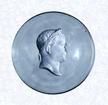Sulphide Technique

Sulphide Portrate of Napoleon I
History of Cameos
Included in the Barker Collection are sulphides of nineteenth-century personages, religious subjects, and other contemporary themes. The impetus for creating sulphides can be traced to the neoclassical revival that seized Europe after the excavations of the sites of Herculaneum and Pompeii in the eighteenth century. The word "medallion" refers to an ancient Greek large coin. The cameos or portraits on the medallions were a commemoration of a personage.
Early curiosity about the life and art of the classic past created romantic interest in antiquarian objects. As a result, many antiquary shops were soon depleted of their ancient Roman rings, cameos, and other unearthed objects. To meet this demand, artisans began creating imitations of classical subjects in gemstone, wax, mollusk shell, glass paste, and porcelain.
The Process of Making Sulphides
The innovative concept of enclosing a porcelain material depicting classical subjects within glass was originally conceived in Bohemia during the late eighteenth century. Although these early attempts were not completely successful, the technique of cameo incrustation was perfected in France by 1800. In 1819 Apsley Pellatt took out a patent on "crystalo ceramie," the encasement of a porcelain medallion in glass, a subject about which he wrote a book in 1821. Successful experimentation with cameo incrustation led to the discovery of a silica-clay mixture with a higher melting point that molten glass and a compatibility with glass in expansion and contraction.

Enclosing a sulphide cameo in glass
Another of Apsley Pellat's books, Curiosities of Glass Making, written in 1849, illustrates the methods used. After molding, the cameo was fired and allowed to cool. It was then gradually heated and held in readiness while the artisan blew a small bubble at the end of a blowpipe. An opening was cut into the end of the bubble, the cameo inserted, and the opening in the bubble sealed. The artisan then collapsed the reheated bubble by extracting air through the blowpipe with his mouth. The collapsed glass tightly enveloped the entire cameo.
Another description of making sulphides paperweights lists these steps:
- shaping the paperweight
- reheating before placing the sulphide
- placing the sulphide with tongs onto the gather, which is on the pontil
- adding a colored ground by positioning a second gather of colored glass on the sulphide's and weights lower surface (while still on the pontil) and cutting the colored glass off with shears.
- removing the weight from the pontil.
These early glass-sheathed sulphides were enclosed in plaques, pendants, tumblers, goblets, vases, bottles, religious shrines, lusters (glass pendants decorating a candlestick or a chandelier), doorknobs, and other glass objects. Later, as companies began to manufacture paperweights, sulphides were included as a design element.










